At Duolingo, one of our guiding principles has always been continuous improvement – improvement of everything from the technology behind the app to how effectively we teach languages. If you’ve been a regular user of Duolingo this past year, chances are that you’ve noticed some pretty big changes we have made to the learning experience with the introduction of new features and updated course material.
As we inch closer to the end of 2019, we would like to highlight some of the major improvements we have made to our learning experience this year, and look ahead to what we’ll be focusing on in 2020. In this post, we’ll cover updates including:
- Rebuilding Duolingo’s courses to align with the CEFR
- Bringing Duolingo Stories to mobile
- Launching the Duolingo French Podcast
- Bringing back spaced repetition at the skill level
- Testing the addition of Smart Tips
- Testing new types of exercises, including audio lessons!
CEFR course alignment
Among the biggest changes we’ve made this year was rebuilding some of Duolingo’s most popular courses from scratch, ensuring that the course material aligned to the Common European Framework of Reference for Languages (CEFR). This is the most commonly used language standard worldwide, and it was developed to provide a common basis for talking about language education. The CEFR defines what a learner should be able to do (the so-called “Can Do” statements) at different levels of proficiency in their new language, i.e. “the learner can order food” or “the learner can talk about likes and dislikes.”
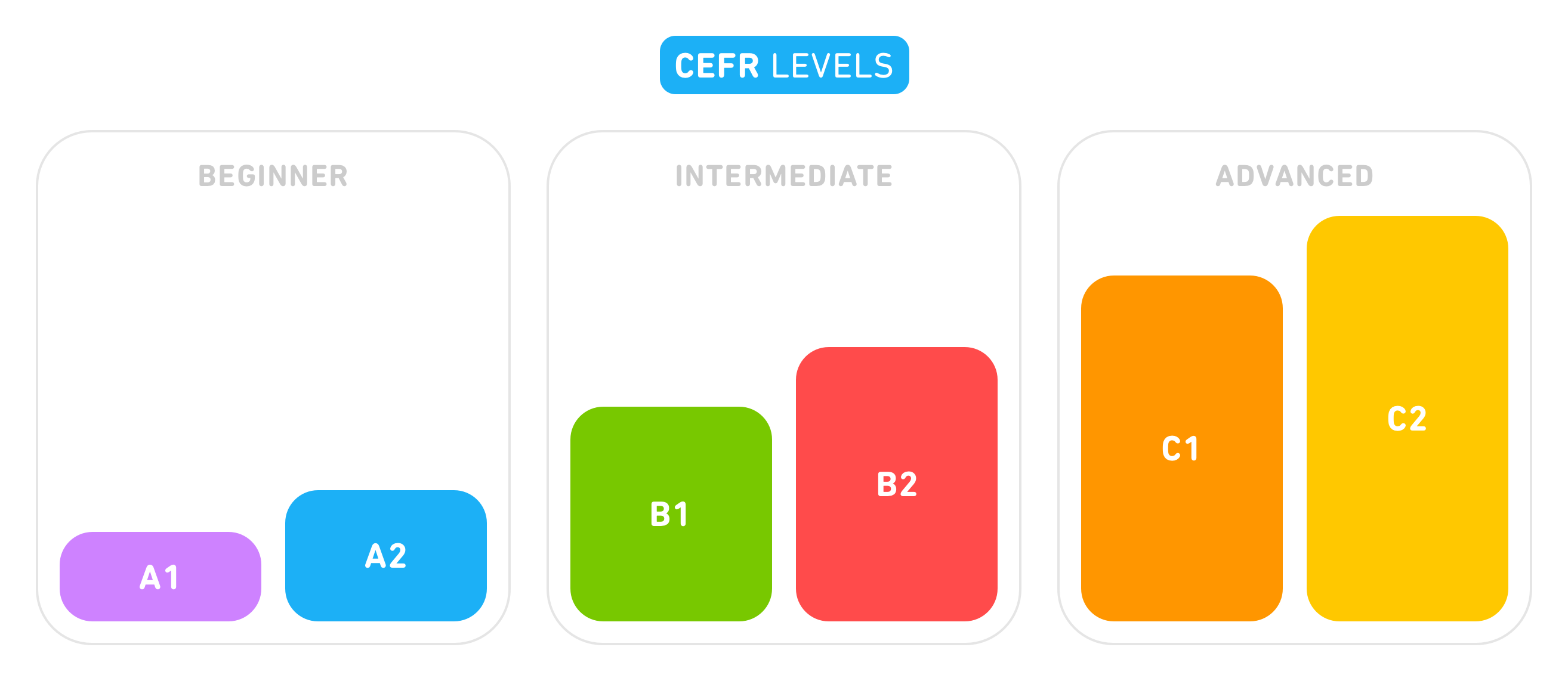
If you’re an English speaker learning Spanish or French (or a Spanish or Portuguese speaker learning English), those courses now cover all the A1- and A2-level content. We are also working on ways to effectively teach B1-level material, including developing eight new types of exercises that provide a more monolingual experience. These exercises are being piloted on our French course for English speakers first, and if successful, will be offered in other courses soon!
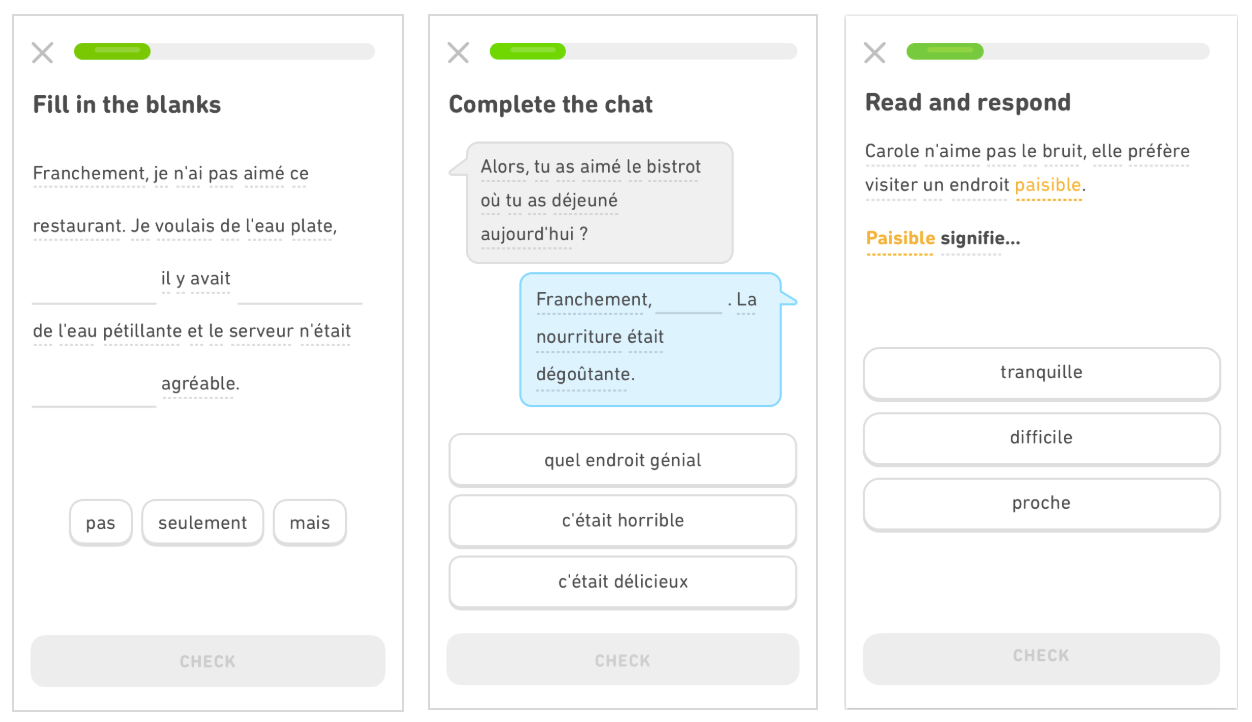
We want all of our courses to meet CEFR standards so that our learners can achieve the benchmarks they need for their personal and professional goals. This means that we will continue revamping courses and working with our volunteer contributors to help them apply CEFR standards to the courses they create.
Addition of Duolingo Stories to the mobile apps
Our team is constantly working on developing new resources to account for different parts of the language-learning journey, especially for intermediate-level learners. For instance, we’ve launched the Duolingo Spanish and French Podcasts to provide learners an engaging way to improve their listening comprehension, and we offer in-person Duolingo Events that connect learners in cities worldwide to practice conversation in the languages they’re learning.
Another key learning feature we’ve developed is Duolingo Stories. These are short, interactive, and (in true Duolingo spirit) quirky stories designed to help with both reading and listening comprehension. Duolingo Stories have been available as a web-only feature since 2017 and are now available on the Duolingo iPhone and Android apps for English speakers learning Spanish, French, German, and Portuguese, as well as Spanish, Portuguese, and Chinese speakers learning English. Each of the stories is carefully crafted to complement Duolingo’s courses and is brought to life with full audio voiceover and interactive moments that test for comprehension.
The positive feedback we have received from learners about Duolingo Stories has been very encouraging, and we look forward to soon bringing the Stories experience to iPad users as well!
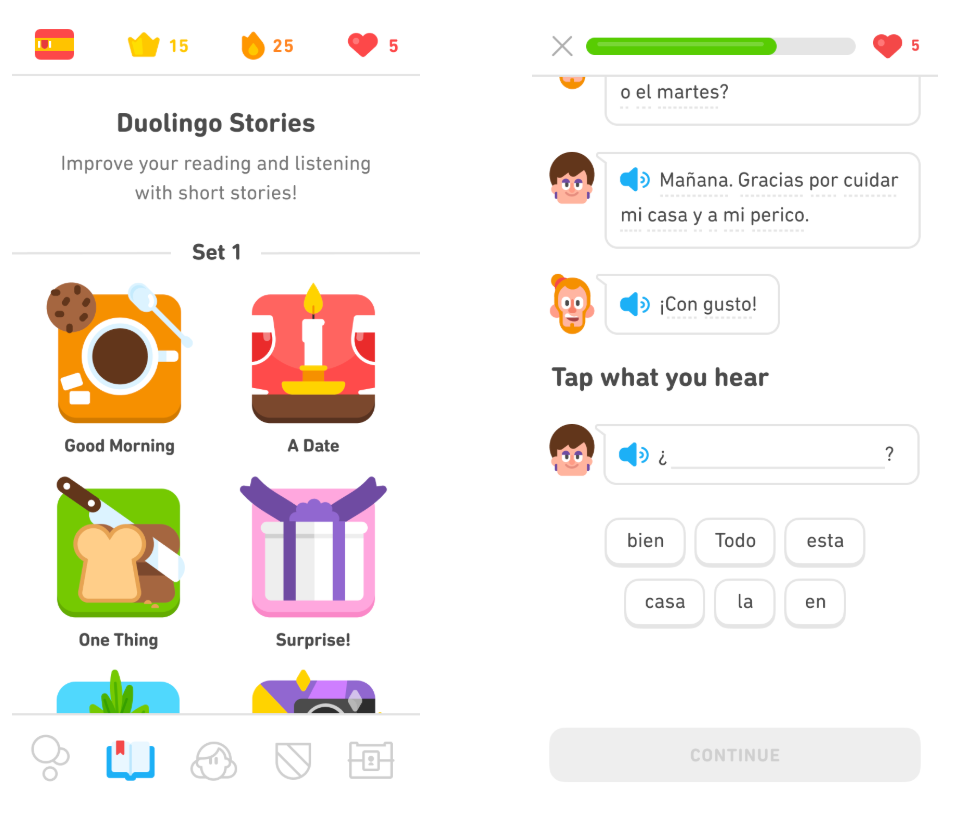
Launch of a podcast for French learners
Two years ago, we launched the Duolingo Spanish Podcast as a resource to help Spanish learners improve their listening comprehension. Since then, it has reached more than 20 million total downloads over the course of five seasons. The podcast follows a unique format, with each episode featuring a fascinating, true story told in easy-to-understand Spanish by a native speaker, along with narration from an English-speaking host throughout. This year, we've featured stories from world-renowned Mexican opera singer Javier Camarena and Tatiana Calderón, the only female driver in Formula 2 racing – in addition to stories from Paraguay, Chile, Colombia, and more.
On the heels of the Spanish Podcast’s success, we launched the Duolingo French Podcast earlier this year. Similar in format to our Spanish Podcast, the French Podcast features compelling storytelling to help learners improve their listening comprehension while hearing and learning from people who represent the diversity of French speakers globally. The first season featured stories like that of Mahmoud M’Seddi, the son of Tunisian immigrants who was the youngest-ever winner of France’s Grand Prize for Best Parisian Baguette in 2018 – as well as stories from Cameroon, Réunion Island, Martinique, and more.
Our team is hard at work on the second season of the Duolingo French Podcast (and the sixth season of the Spanish Podcast), so stay tuned for brand-new stories coming soon!

Reintroduction of spaced repetition at the skill level
With our Crown Levels update last year, many of our learners noticed that Duolingo courses no longer explicitly leveraged spaced repetition at the individual skill level. Spaced repetition is a proven learning technique that involves revisiting information regularly at set intervals over time to put it in long-term memory. We know it’s an important technique when it comes to learning a language, so we wanted to find ways to reintroduce it at the skill level (our global practice option has continued to use the spaced repetition algorithm).
Once learners reach Level 5 on a skill, the skill icon turns gold as a sign that they’ve mastered that particular skill. However, as learners continue advancing throughout a course, it becomes easy to forget material that was learned earlier on. Now, when our spaced repetition algorithm deems it’s time to review concepts taught in a skill, the skill will turn from a Level 5 gilded skill to a Level 5 “shattered” skill. This signals to the learner that it’s time to review that content. Doing a practice lesson on the shattered skill will restore the skill back to its full golden glory.

Testing freeform writing skills
In an effort to improve in-app assessment, we introduced a checkpoint quiz earlier this year. It appears at the end of each section in our CEFR-aligned courses and helps us determine how well we’re teaching different concepts, such as the past tense or vocabulary needed to order at a restaurant. When learning a language, we understand it’s important to train both receptive (reading, listening) and productive (writing, speaking) skills. This is why we recently added a new type of test item to our quiz that allows us to assess how well our learners are doing at freeform writing.
The new freeform writing test item requires learners to answer an open-ended prompt in up to 200 characters. This not only creates a more challenging experience for learners, but it gives our team valuable insight into how much people have learned up until that point. In addition to this test item, we are working on integrating freeform writing into the Duolingo teaching experience to help learners continuously improve in this area.
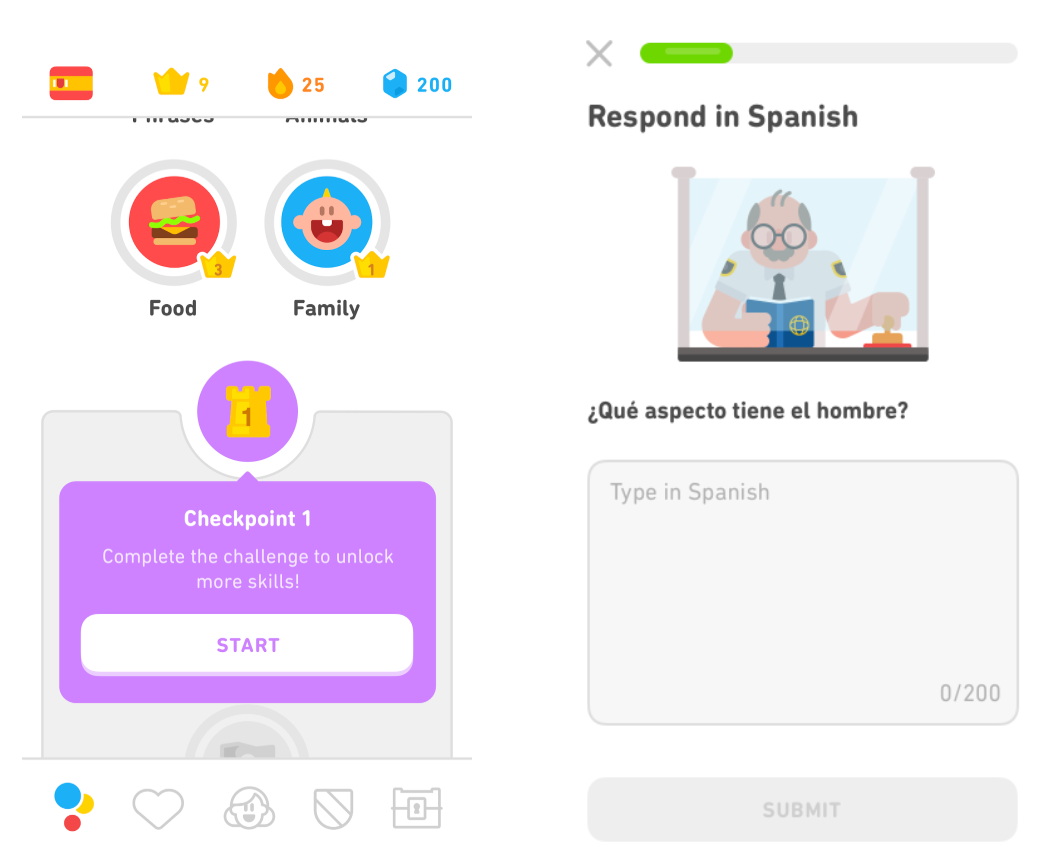
What we’ll be working on in 2020
The New Year will be here before we know it, and with that, we would like to share some of the challenges that we’re aiming to solve for in 2020 in order to make the Duolingo learning experience even more robust.
Offering more monolingual content
We know that language learning often works best when learners are immersed in their target language. This is why we plan to add more monolingual course content as we work toward aligning Duolingo’s learning content with higher CEFR levels. In order to adequately teach to the B1 level, for example, we have developed several new types of exercises that focus almost entirely on the language you’re learning; in other words, we’re providing a more monolingual experience to help you get comfortable with the language you’re learning – without relying as much on translation.
Some of the monolingual exercise types we have been testing include a reading comprehension exercise that requires you to read a short passage and answer a comprehension question about it; a listening exercise that prompts you to listen to a passage and then answer a question about it; and an exercise where you’re given an image and then instructed to complete a sentence describing the image.
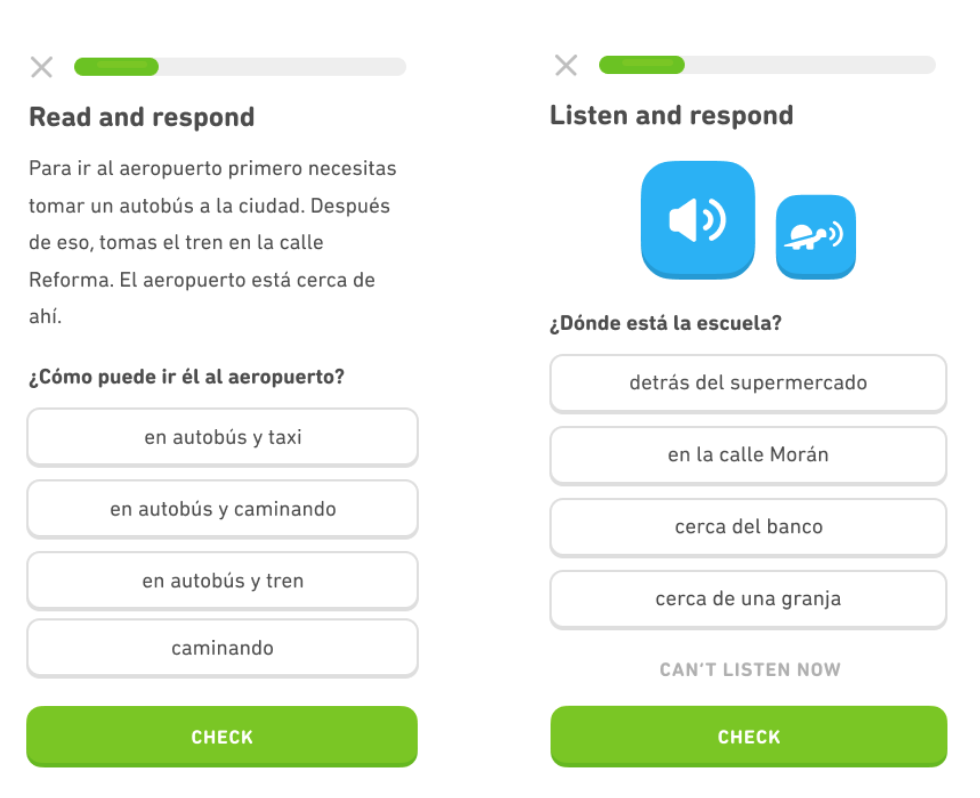
By incorporating these exercise types and more in B1-targeted skills on Duolingo, we’re able to offer a more advanced and immersive experience for learners.
Making Tips “smarter”
Last year, we introduced Tips, which provide short explanations of tricky concepts to help our users learn better. Our Tips include simple grammar rules (e.g., verb conjugation), pronunciation pointers, and explanations of concepts that just aren’t intuitive (e.g., Spanish “tú” vs. “usted”).
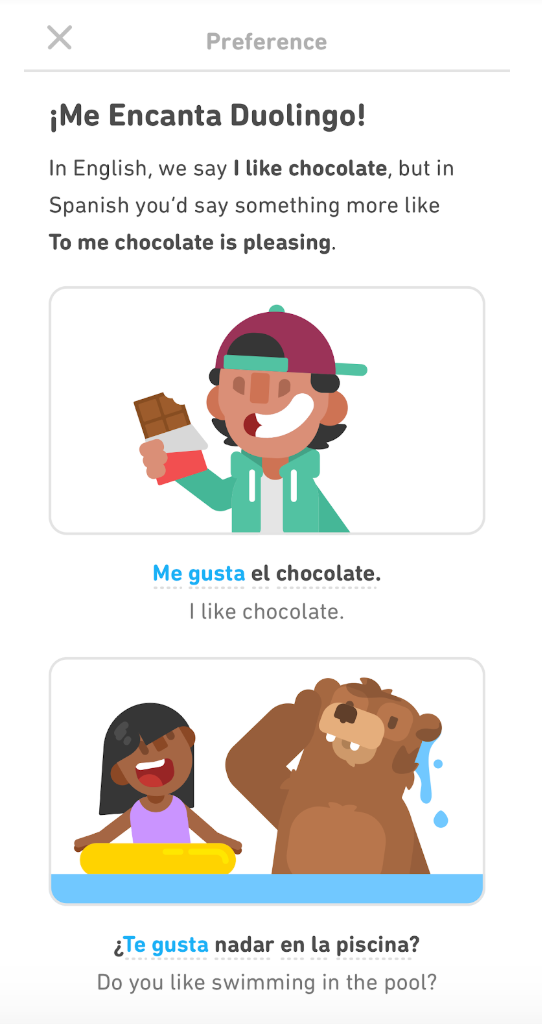
This past year, we have been working on enhancing the Tips experience by testing Smart Tips. The key difference is that Smart Tips provide learners with real-time feedback and instruction: when you make a mistake on Duolingo, if we recognize the mistake, we’ll provide a helpful explanation about that mistake and a small exercise to complete to solidify your new knowledge.
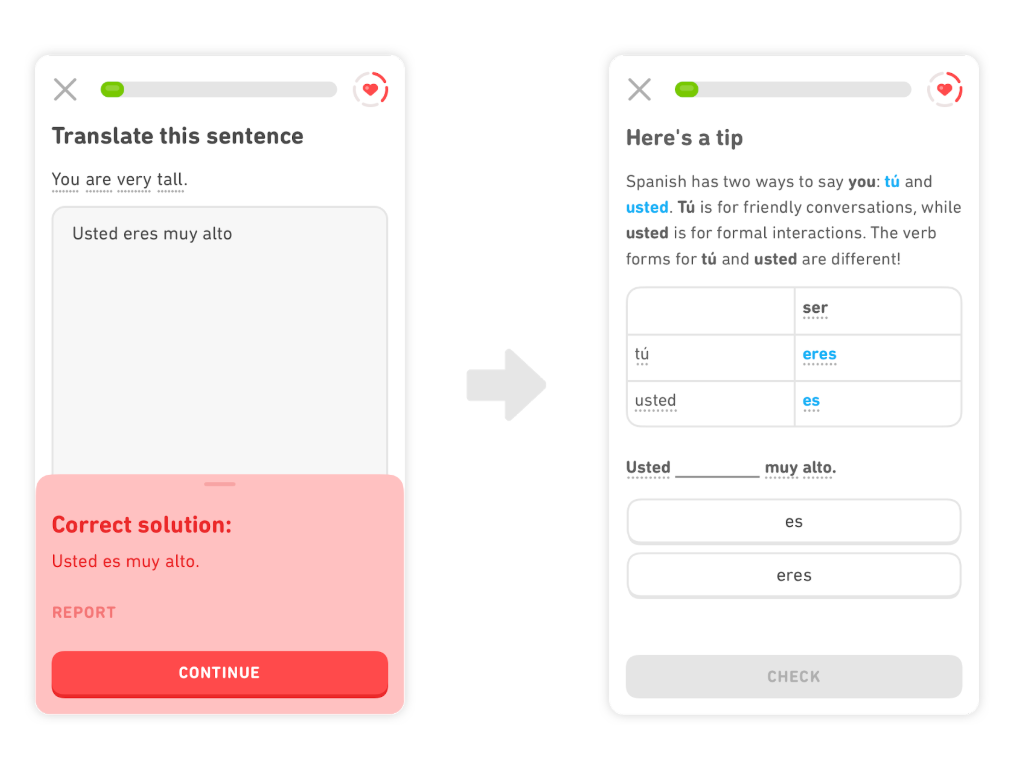
Testing, testing… audio lessons
There is little use in learning a foreign language if you can’t see it being used in real contexts. This is where audio-based content can play a strong role. Starting with our French course for English speakers, we have been testing a completely new type of lesson that helps you practice both listening and speaking, as well as understand how the language is used in context.
We've been testing five-minute audio lessons on different topics to not only help you with your listening skills, but also to practice speaking. Unlike the typical Duolingo app learning experience, the audio lessons can be done entirely hands-free, giving you the option to learn while you are on the go.
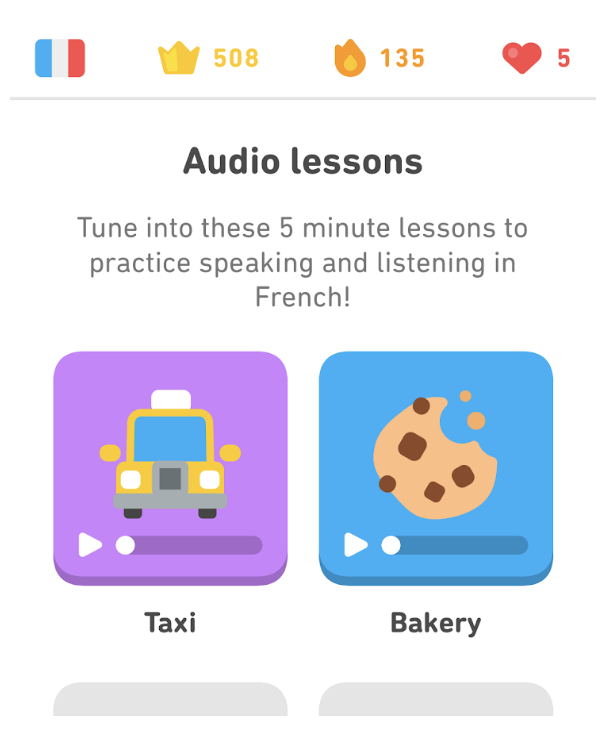
At our core, we’re a team of problem-solvers, and we have been energized and encouraged in running these experiments as we work toward creating an even more robust learning experience for our learners. In the spirit of continuously improving the Duolingo learning experience, we look forward to further testing and iterating on all of these features and more in the New Year. Stay tuned!



